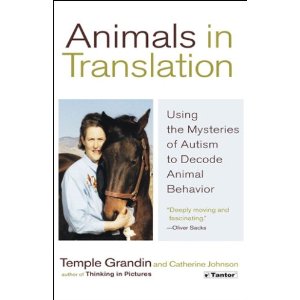Temple Grandin is autistic, which means that her brain works in profoundly different ways from the brains of nonautistic people. For Temple this means that she can easily relate to animals and understand their behavior in a much more intimate manner.
Humans are animals. We live and die in the exact same ways as any other animal on Earth-the big difference is that we can think about it while it is happening. Temple Grandin’s Animals in Translation works on the theory that other animals are not all that different from the human animal after all.
Anthropomorphism is giving human motivation and reasoning to non-humans, such as animals. Temple Grandin often blurs the line between science and non-science in Animals in Translation. She freely gives human motivations and feelings to animals-going so far as to believe that animals and autisics have similar brains. She refers to animal breeding habits that she hates as rape and tells us that animals murder each other-though never through their own fault of course, but because of the actions of people.
I grew up with dogs and cats and had a couple of friends who owned horses. I’ve seen dogs chase cats in their dreams, had a horse run up to me with every indication that I was someone missed, and I’ve been snubbed by cats who are too busy to be bothered with a mere human. To Temple Grandin these animal behaviors are part of the animal’s natural tendencies and humans are always screwing things up for them.
I remember being at the Minnenapolis Zoo and watching beavers in their exhibit. It was a nice exhibit, a number of beavers, a body of water, a beaver lodge, a small water spillway-all things that make for a good looking beaver exhibit. But whoever designed this habitat seemed to have left out one major element-trees. This would be like designing a squerril habitant without nuts and soft ground to dig in. But there was one stick in the exhibit. A beaver found the stick and was, to all apperances, happy as a beaver could be. He instantly swam over to the little waterfall made by the spillway and tried to block it with his one little stick. He was unable to build a dam with the one stick and he gave up and took his stick into the beaver lodge. There was a camera in the lodge so you could see inside. The beaver took the stick and placed it in the lodge, then went back outside. A few moments later another beaver entered the lodge. When he saw the stick he got this OMG expression and ran over and grabbed the stick and promtly left with it. A few moments later the first beaver returned and he had a WTF expression on his face as he looked around in horrror at finding that his stick was gone.
I’ve told this story to people who has said I was just anthromorphising their behavior and they weren’t really happy at finding the stick and unhappy at no longer having it. But I’m sure that Temple Grandin would agree that the beavers are happier when they have wood to work with. The Minnesota Zoo’s webpage says that it gives the beavers wood-so maybe it was just al chewed up by the time we got there.
Animals in Translation: Using the Mysteries of Autism to Decode Animal Behavior is an amazing book filled with wonderful and disturbing stories about Temple’s time spent with animals and the ignorant people who control thier lives and deaths and destiny. It is disturbing have breeders have created so many mutant animals and there is no telling what the future holds now that Genetic Engineering has removed all barriers to what an animal can be turned into. Temples talks about her work with horses, cows, pigs, and dogs. She also talks about lab rats and how she believes that it is possible that much of what we have learned from them is flawed and meaningless-as the white rats have lived outside the real world for too long and that they have been unduly influence by the people conducting the expriments.
This is gripping stuff and makes you rethink the entire history of mankind’s relationship with all of nature.
- Starfield – A Few Months In - December 23, 2023
- Still Just A Geek by Wil Wheaton - November 1, 2022
- Starfield First Impressions of Gameplay Reveal - June 13, 2022

Yes, Temple Grandin is awesome. I feel sorry for those beavers! And as much as I enjoy going to the zoo, Fossil Rim will always be my favorite memory of seeing animals up close and personal.
I enjoyed Fossil Rim as well, and I have a soft spot for Arbuckle Wilderness. My all time favorite odd little animal exhibit was at Clark’s Trading Post, where a number of bears have been trained to do all kinds of interesting things.